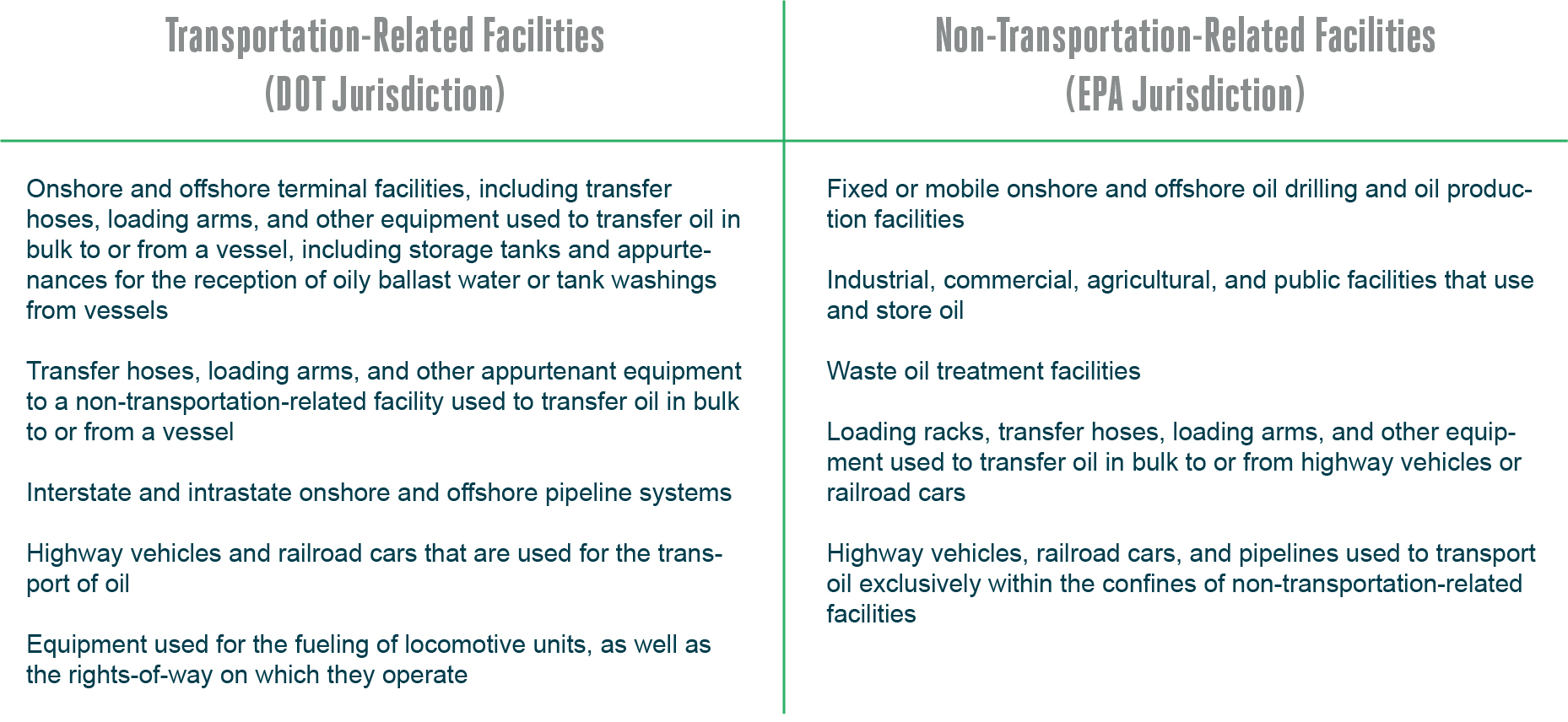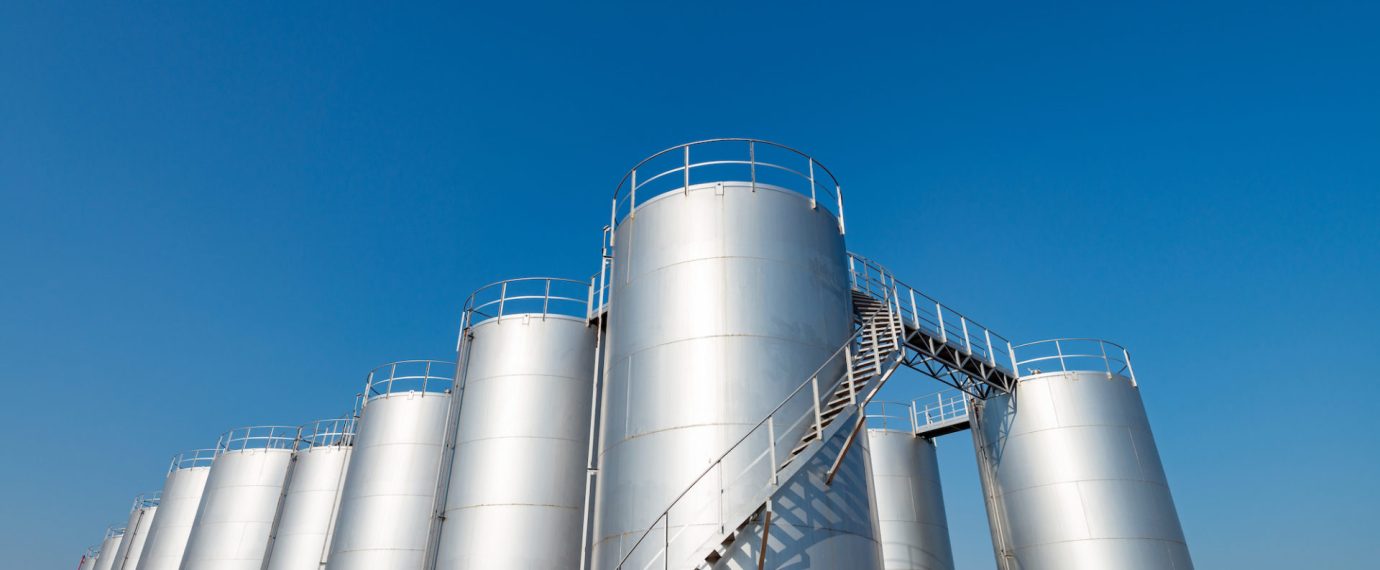The purpose of an SPCC Plan is to establish a comprehensive program that mitigates oil spills from reaching navigable waters and describes the necessary equipment, engineered controls, and procedures in place to prevent oil spills from occurring. The SPCC Rule is controlled under The Oil Pollution Prevention Regulation, which is outlined in Title 40, Part 112 of the Code of Federal Regulations. For a facility to be applicable under the SPCC Rule, they must:
- Be non-transportation-related;
- Have aggregate bulk oil storage equal to or greater than 55 gallons with a total accumulation of more than 1,320 gallons, or have a completely buried oil storage capacity greater than 42,000 gallons; and
- Reasonably be expected to discharge oil to navigable waters or adjoining shorelines in potentially harmful quantities.
Non-Transportation-Related – EPA/DOT Jurisdiction
If a facility is regulated under 40 CFR part 112, there are three groups that facilities will fall under: transportation-related facilities, non-transportation-related facilities, and complexes. The difference between the three groups is established through Executive Orders (EOs) and Memoranda of Understanding (MOUs).
To know if the facility is exempt from the SPCC rule under the 1971 MOU, Appendix A of 40 CFR part 112 Section 112.1(d)(1)(iii) lists out facilities that are classified as transportation-related onshore and offshore facilities. All exempt facilities that are classified as offshore facilities under the 1994 MOU are listed out in Appendix B of 40 CFR part 112 Section 112.1(d)(1)(iii).
Examples of facilities that may be transportation-related versus non-transportation-related include:

For facilities that can be both transportation-related and non-transportation-related, activities are subject to both EPA and DOT or USCG jurisdictions. Facilities in this situation need to evaluate the activities carefully to determine the correct jurisdiction.
Applicable Containers
If a facility drills, produces, gathers, stores, processes, refines, transfers, distributes, uses, or consumes oil and oil products and is not transportation-related, the next step is to determine if the amount of oil is over the threshold. All containers of oil with a capacity of at least 55 gallons are applicable under the SPCC Rule. If the facility has a total accumulation of 1,320 gallons or more made up of containers with capacities of at least 55 gallons, they are required to develop an SPCC Plan. In other less common situations, a completely buried oil storage capacity greater than 42,000 gallons would also be required to have an SPCC Plan.
Bulk storage containers are not the only type of container applicable to the rule. Oil-filled equipment, oil-filled machines, and flow-through process vessels are other types of containers that would count towards the 1,320-gallon threshold. Some examples of oil-filled equipment and oil-filled machines include wet transformers, emergency diesel fuel generators, machining coolant systems, and heat transfer systems.
The type of containers that are exempt from the rule include:
- Permanently closed containers
- Motive power containers
- Hot-mix asphalt or any hot-mix asphalt containers
- Single-family residential heating oil containers
- Pesticide application equipment or related mix containers
- Milk and milk product containers and associated piping
- Completely buried tanks (subject to 40 CFR part 280)
- Underground storage tanks
- Containers used exclusively for wastewater treatment
Reasonably Impact Navigable Waters
Once it is determined that the facility is non-transportation-related and over the 1,320-gallon/42,000-gallon threshold, the final step is assessing if the facility can reasonably impact navigable waters. A facility that could discharge oil to navigable waters in quantities that may be harmful would be applicable under the SPCC Rule. Under the Clean Water Act (CWA), oil spills may be harmful if discharges:
- Cause a sheen or discoloration on the surface of the water or adjoining shorelines;
- Cause a sludge or emulsion to be deposited beneath the surface of the water or upon adjoining shorelines; or
- Violate an applicable water quality standard.
Facilities need to evaluate their location based on geography and distance to a stream, ditch, gully, or storm sewer to determine if the facility can reasonably discharge oil to navigable waters. Constructed features such as dikes, equipment, or other manmade structures that prevent, contain, hinder, or restrain an oil discharge are not to be included in the final determination. Publicly owned treatment works (POTW) are also not to be included in the applicability determination. These systems are not designed to handle oil discharges and under certain circumstances, the receiving waters can bypass the treatment system and discharge directly into bodies of waters.
In Summary
It may be difficult to properly identify all applicable containers without the proper knowledge of the rule and an account of all equipment and containers on-site. For this reason, facilities need to conduct a complete inventory of all chemicals stored and used on the premises. Those that meet the oil storage thresholds of 1,320-gallons/42,000-gallons and could reasonably be expected to discharge in quantities that may be harmful into navigable waters are governed by the rule 40 CFR Part 112. Such facilities must then implement SPCC Plans tailored to their facility to prevent an oil discharge.



